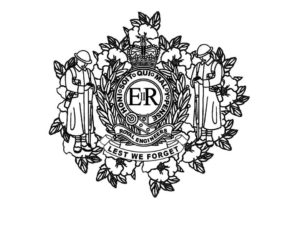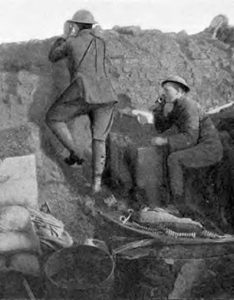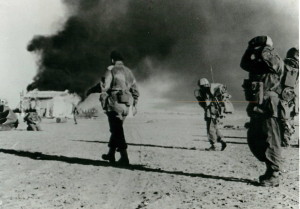
Introduction
This bulletin is inspired by a series of articles reproduced by the Royal Signals Amateur Radio Society and Published in their journal – Mercury, numbers 172 to 174 in 2016, the anniversary of the Battle of the Somme.
These articles covered the formation of Military Signalling prior to 1908 during the Crimean and Boer wars as described by the Royal Signals Museum. They focus on the duties performed by Sappers of the Royal Engineers during World War One, with thanks to WAP Weale, GW0WEE who’s introduction is below. This provides links to further accounts of the sappers themselves made available via the world wide web.
Pre World War One – Organisation
 In 1908 the Telegraph Battalion Royal Engineers based at Aldershot and two companies based in London for telegraph and postal duties formed the nucleus of the Royal Engineers (RE) Signal Service. This organisation provided for the army’s signalling requirements throughout the First World War, it provided motorcycle dispatch riders, and eventually the wireless as it was introduced into warfare however the majority of messages were passed via telephone, heliograph and flags.
In 1908 the Telegraph Battalion Royal Engineers based at Aldershot and two companies based in London for telegraph and postal duties formed the nucleus of the Royal Engineers (RE) Signal Service. This organisation provided for the army’s signalling requirements throughout the First World War, it provided motorcycle dispatch riders, and eventually the wireless as it was introduced into warfare however the majority of messages were passed via telephone, heliograph and flags.
Communications Organisation in 1914
The RE Signals Service, in most cases, was split into smaller units, none bigger than Company size, and attached to Divisions, Corps and Army HQs. As they were attached to the fighting portions of Divisions, so men of the Signals Service saw action and were involved in most battles.

Line Laying Team
In 1914 each infantry division included a signals company of approximately 162 men, organised into a Company HQ and four sections. No.1 section was responsible for Divisional HQ communications, and Nos 2-4 sections with the divisional brigades.
The normal composition of each divisional company was something in the order of an Officer Commanding (Major), four Lieutenants, one for each section, twenty-five other ranks at Divisional HQ and 132 other ranks spread across the remainder of the division and brigade HQs.
Transportation and Personal Equipment
Signals Companies used horses for transport and had an establishment of about thirty-three riding horses, forty-seven draught horses and four pack horses. Additionally, they had thirty-two pedal cycles and nine motor cycles. With the exception of the Trumpeter, all ranks were armed as infantrymen and carried the Rifle, Short Magazine, Lee Enfield (SMLE) widely known as “the smelly”.
Duties
The most common duties associated with the Signals Service were laying communications wire (over which the telegraph was employed); operating same; repairing same, carrying messages (either on foot or by horse) handling and dispatching of mail (both official and private); constant trade practice and of course the inevitable trench digging and maintenance which they shared with their infantry colleagues. There was also mundane guard duties and maintenance of their horses and equipment.

Artillery Spotting
Signallers were also used in forward positions to assist the artillery and provide information on their enemy targets. In these, often isolated, positions the signaller became vulnerable to enemy fire, and many signallers lost their lives.
Further Accounts:
- A personal memoir and biography describing the duties of Sapper Arthur Haletrap MBE during world war one can be read here
- B. Neyland served from September 1916 to December 1919 as a Sapper, in a Royal Engineers (Signals), Wireless Section and his account is posted here.
- An account by Mike Gater of his father, 252696 Sapper Gater RE is given here.

RE Signals Corporal Operating Trench Wireless
Wireless
With the gradual introduction of the wireless as the war developed so the Signals Companies embraced this new technique. But it never replaced the reliability at the front line of the telegraph in this conflict. It took some time for commanders and signallers to understand what wireless offered them, and its limitations. For example, while intercept of telephone was common it took time to realise that wireless transmissions could be intercepted by the enemy. (However see here for a more in depth view).
Alternative Means of Communication
Where landlines were unavailable or broken by shellfire alternative methods of communication were used. Semaphore, using the army’s one-flag system, was also in use in the early part of the war but was subsequently banned in the trenches as its use was guaranteed to attract enemy fire! Out of sight of the enemy, visual signalling was used which made use of light, either from sunlight (the heliograph) or at night using Lucas Lamps. In all cases messages were sent in Morse Code.

An Officer using the Fullerphone
The standard field telephone used with landlines consisted of a wooden box containing two dry cells, a magnet generator, polarised bell, induction coil testing plug and a hand-held telephone C Mk 1. Towards the end of 1916 these were being replaced by the Fullerphone and by 1918 many divisions adopted them in their forward positions.
Command and Control in 1916
It wasn’t until the 1920s that command and control systems developed into what they are today. As mobile warfare using the tank developed so did the use of radio. The most quoted example of modern mobile warfare is the Blitzkrieg in which combined operations were coordinated by the prolific use of radio. But it is noted line, and dispatch riders also play significant roles as alternative means of communication.
Up until this time it is poignant to consider the traffic handling capabilities of the message handling systems in World War 1. Commanders had a daunting amount of written correspondence to sift through, to glean intelligence and plan operations.
The amount and volume of messaging often led commanders to the point of breakdown and when the army moved to attack, it often had no idea about the size and location of enemy troops until it came upon them, such was the situation at the battle of the Somme in 1916.
We will remember them.
Stuart Dixon
The author acknowledges the Imperial War Museum for its creative commons media and is grateful to Mike Collins for his images used in this article.



 In 1908 the Telegraph Battalion Royal Engineers based at Aldershot and two companies based in London for telegraph and postal duties formed the nucleus of the Royal Engineers (RE) Signal Service. This organisation provided for the army’s signalling requirements throughout the First World War, it provided motorcycle dispatch riders, and eventually the wireless as it was introduced into warfare however the majority of messages were passed via telephone, heliograph and flags.
In 1908 the Telegraph Battalion Royal Engineers based at Aldershot and two companies based in London for telegraph and postal duties formed the nucleus of the Royal Engineers (RE) Signal Service. This organisation provided for the army’s signalling requirements throughout the First World War, it provided motorcycle dispatch riders, and eventually the wireless as it was introduced into warfare however the majority of messages were passed via telephone, heliograph and flags.



 Radio Branch Flies its Flag at Key Corps Events
Radio Branch Flies its Flag at Key Corps Events Electronic Warfare – BBC says No Change despite advances in Battlefield Communications
Electronic Warfare – BBC says No Change despite advances in Battlefield Communications